The GeForce GTX 660 Ti Review, Feat. EVGA, Zotac, and Gigabyte
by Ryan Smith on August 16, 2012 9:00 AM ESTOC: Power, Temperature, & Noise
Our final task is our look at the overclocking capabilities of our GTX 660 Ti cards. Based on what we’ve seen thus far with GTX 660 Ti, these factory overclocked parts are undoubtedly eating into overclocking headroom, so we’ll have to see just what we can get out of them. The very similar GTX 670 topped out at around 1260MHz for the max boost clock, and between 6.6GHz and 6.9GHz for the memory clock.
| GeForce 660 Ti Overclocking | |||||
| EVGA GTX 660 Ti SC | Zotac GTX 660 Ti AMP | Gigabyte GTX 660 Ti OC | |||
| Shipping Core Clock | 980MHz | 1033MHz | 1033MHz | ||
| Shipping Max Boost Clock | 1150MHz | 1175MHz | 1228MHz | ||
| Shipping Memory Clock | 6GHz | 6.6GHz | 6GHz | ||
| Shipping Max Boost Voltage | 1.175v | 1.175v | 1.175v | ||
| Overclock Core Clock | 1030MHz | 1033MHz | 1083MHz | ||
| Overclock Max Boost Clock | 1200MHz | 1175MHz | 1278MHz | ||
| Overclock Memory Clock | 6.5GHz | 6.8GHz | 6.6GHz | ||
| Overclock Max Boost Voltage | 1.175v | 1.175v | 1.175v | ||
As we suspected, starting with factory overclocked cards isn’t helping here. Our Zotac card wouldn’t accept any kind of meaningful GPU core overclock, so it shipped practically as fast as it could go. We were able to squeeze out another 200MHz on the memory clock though.
Meanwhile our EVGA and Gigabyte cards fared slightly better. We could push another 50MHz out of their GPU clocks, bringing us to a max boost clock of 1200MHz on the EVGA card and 1278MHz on the Gigabyte card. Memory overclocking was similarly consistent; we were able to hit 6.5GHz on the EVGA card and 6.6GHz on the Gigabyte card.
Altogether these are sub-5% GPU overclocks, and at best 10% memory overclocks, which all things considered are fairly low overclocks. The good news is that reference-clocked cards should fare better since their headroom has not already been consumed by factory overclocking, but binning also means the best cards are going to be going out as factory overclocked models.
Moving on to our performance charts, we’re going to once again start with power, temperature, and noise, before moving on to gaming performance.

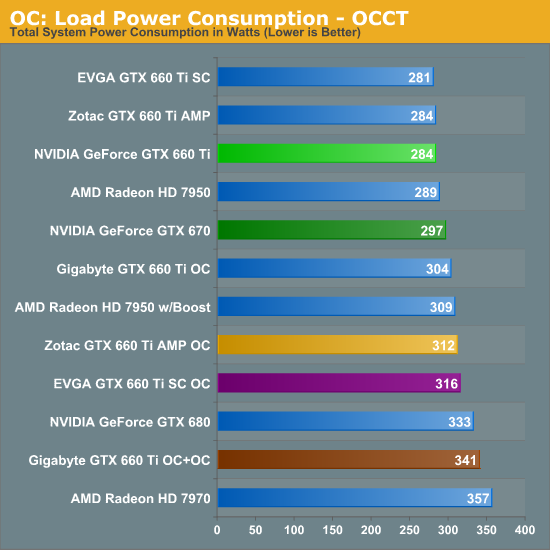
Unsurprisingly, given the small power target difference between the GTX 670 and the GTX 660 Ti, any kind of overclocking that involves raising the power target quickly pushes power consumption past the GTX 670’s power consumption. How much depends on the test and the card, with the higher power target Gigabyte card starting with a particular disadvantage here as its power consumption ends up rivaling that of the GTX 680.
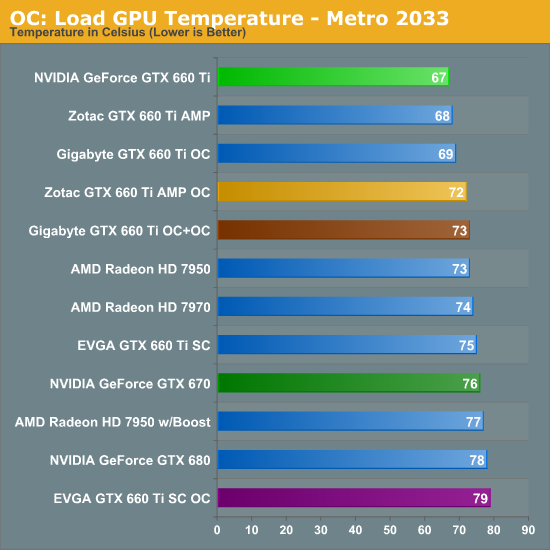
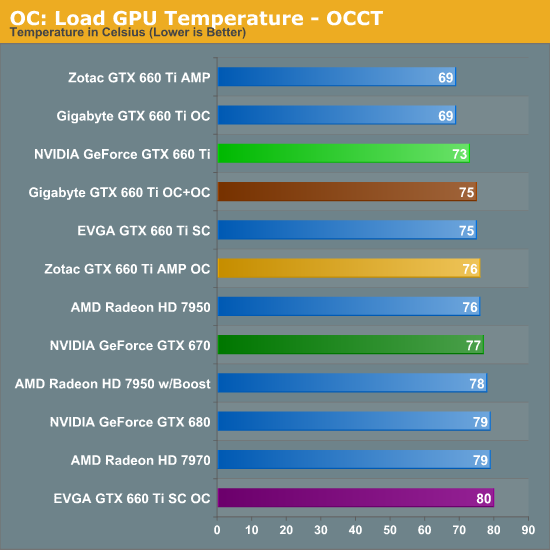
We also see the usual increase in load temperatures due to the increased power consumption. The Zotac and Gigabyte cards fare well enough due to their open air coolers, but the blower-type EVGA card is about as high as we want to go at 80C under OCCT.
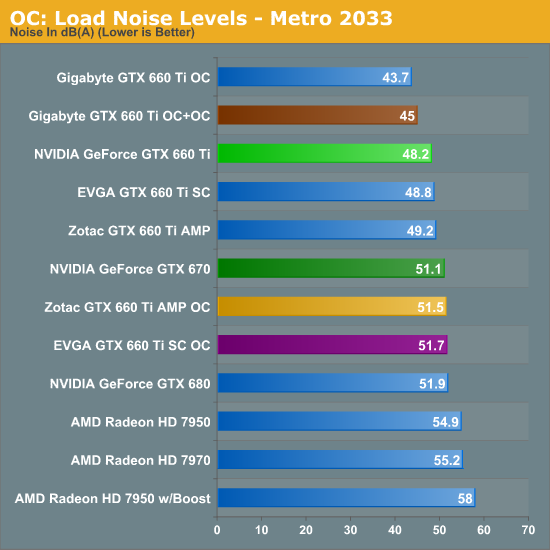
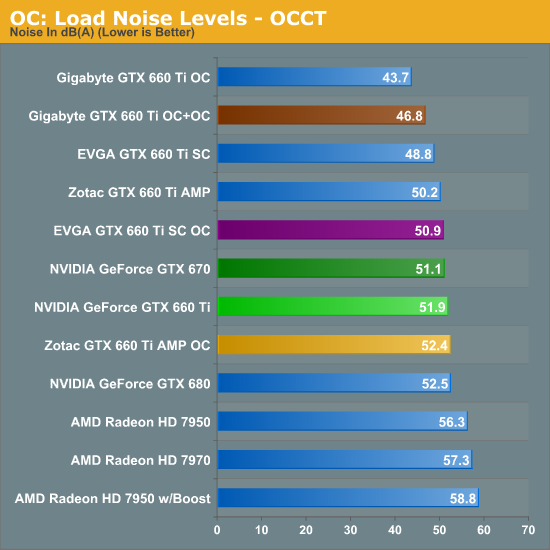
Last but not least, looking at noise levels we can see an increase similar to the temperature increases we just saw. For the Zotac and EVGA cards noise levels are roughly equal with the reference GTX 680, which will be important to remember for when we’re looking at performance. Meanwhile the Gigabyte card continues to shine in these tests thanks to its oversized cooler; even OCCT can only push it to 46.8dB.










313 Comments
View All Comments
TheJian - Monday, August 20, 2012 - link
660 can go to 1100/1200 as easily as the 7950 gets to 1150 (so another 10% faster)..Check the asus card I linked to before. You'll have a hard time catching the 660 no matter what, it costs you also as noted by anandtech, my comments on watts/cost/heat etc.Memory bandwidth isn't the issue. here and all of it overclocks fairly close. We don't run in 2560x1600. It's not the weakness. That is a misnomer perpetuated by Ryan beating it like a dead horse when only 2% of users use any res above 1920x1200. I just debunked that idea further by showing even monitors at newegg including 27 inchers don't use that res. IE, no, bandwidth isn't the problem. Bad review on ryan's part, and no conclusion is the problem. The CORE clock/boost is the thing when it's not an bandwidth issue, and it's already been shown to not be true.. LOL, yep, nvidia conspiracy, the minimums were used here to...ROFL. Good luck digging for things wrong with 660TI. Minimums are shown at hardocp, guru3d, anandtech and more. Strange thing you even brought this up with no proof.
The NV cards have only been upped 100mhz, which is about ~10%, not 20 like you say. 915/1114 isn't 20%. You CAN get there, but not in out of box exp. I'd guess nearly all of the memory will hit 6.6ghz. Common for 7970OC / gtx680 to hit 7+ghz.
Galidou - Monday, August 20, 2012 - link
I said 20% because most of their cards are way above reference clocks, I was just representing the reality, not the reference thingys. When you can buy factory overclocked cards at the same price, let's say 10$ premium, mentioning the reference clocks is almost... useless. Plus over the internet, 80% of the reviews had factory overclocked cards so the performance we see everywhere and is in everyone's head, is close to 20% overclock has been done.So in fact there's maybe 10-15% of the juice left for fellow overclockers. I'm estimating, it could be more in the case of better chips. While the 7950 as we know it, has been reviewed everywhere on it's reference clocks/fan and if you take an aftermarket cooler and get, let's be honest and say 40%, it's far ahead in terms of comparison from the reference reviews we have.
And again and for the last time, it all depends on the games.
Galidou - Monday, August 20, 2012 - link
When I look at things again and again. the memory bandwidth doesn't seem to be much of a problem. The only games where I can guess it could harm it is any new games that will come out with directx11 heavy graphics. Something that taxes the cards on every aspects, else than that, for now, the card doesn't seem to have any weaknesses at all.I never thought that for the moment it was a real weakness for it, the future will tell us but even there, 90% of the gamers plays at 1080p or less and 80% of that 90% pays less than 150$ for their video cards. For those paying more, it all depends on choosen side, games they play, overclocking or not and money they want to spend.
Remove overclocking of the way Nvidia wins almost everything by a good margin. Anyone playing 1080p won't be deceived by any 200$+ card if they are not so inclined playing everything on ultra with 8x MSAA.
CeriseCogburn - Thursday, August 23, 2012 - link
You're going to have a CRAP experience and stuttering junk on your eyefinity in between crashes.Come back and apologize to me, and then thejian can hang his head and tell you he tried to warn you.
CeriseCogburn - Thursday, August 23, 2012 - link
Here's the WARNING for you again, with the 660Ti STOMPING your dreamy 7950 into the turf in Skyrim at 2560 x 1080http://www.bit-tech.net/hardware/2012/08/16/nvidia...
RussianSensation - Thursday, August 16, 2012 - link
Hey Ryan,In Shogun 2 and Batman AC at 1080P almost none of the new cards are being stressed. I think you should increase the quality to Ultra for the new 2-3GB generation of cards even if the < 1.5GB VRAM cards suffer and bump AA to 8X in Batman. Otherwise all the cards have no problem passing these benchmarks. Same with SKYRIM, maybe think about adding heavy mods OR testing that game with SSAA or 8xAA at least. Even the 6970 is getting > 83 fps. Maybe you can start thinking of replacing some of these games. They aren't getting very demanding anymore for the new generation of cards.
Ryan Smith - Saturday, August 18, 2012 - link
Russian, it's unlikely that we'll ever bump AA up to 8x. I hate jaggies, but the only thing 8x AA does is to superficially slow things down; the quality improvement isn't even negligable. If 4x MSAA doesn't get rid of jaggies in a game, then the problem isn't MSAA.Consequently this is why we use SSAA on Portal 2. High-end cards are fast enough to use SSAA at a reasonable speed. Ultimately many of these games will get replaced in the next benchmark refresh, but if we need to throw up extra roadblocks in the future it will be in the form of TrSSAA/AAA or SSAA, just like we did with Portal 2.
Biorganic - Saturday, August 18, 2012 - link
I was speaking a bit on both. The article insinuates that the 660ti is on the same performance level as the 7950. The obvious caveat to your results is that it is ridiculously easy to overclock the 7950 by 35-45%, and GCN performance scales pretty well with clock increases. It should be noted in the article that the perf of 7950 OC'd is beyond what the 660ti can attain. Unless you guys can OC a 660ti sample by 30% or more.CeriseCogburn - Sunday, August 19, 2012 - link
Is this the exact same way we recommended the GTX460 reviews ? With some supermassive OC in the reviews, so we could really see what the great GTX 460 could do ?NO>>>>>>>
The EXACT OPPOSITE occurred here, by all of your type people.
Did we demand the 560Ti be OC'ed to show how it surpasses the amd series ? NOPE.
Did we go on and on about how massive the GTX580 gains were with OC even though it was already far, far ahead of all the amd cards with it's very low core clocks ? NOPE - here we heard power whines.
Did we just complain that the GTX680 is not even in the review while the 7970 is ?
Nope.
How about the GTX 470 or 480 ? Very low cores, where were all of you then demanding they be OC'ed because they gained massively.. ?
Huh, where were you ?
Galidou - Sunday, August 19, 2012 - link
Performance scales pretty well on both design but AMD just is a little better at overclocking because it seems like the base clock is terribly underclocked. It just feels like that but that must be for power constraints and noise on reference designs.